Kids Bike Tyre Puncture Again and Again Even if There Is No Nail
A flat tire (British English language: apartment tyre) is a deflated pneumatic tire, which tin can cause the rim of the wheel to ride on the tire tread or the ground potentially resulting in loss of control of the vehicle or irreparable damage to the tire. The nigh common cause of a flat tire is puncturing of the tire by a sharp object, such as a boom or pivot, letting the air escape. Depending on the size of the puncture, the tire may debunk slowly or rapidly.[1]
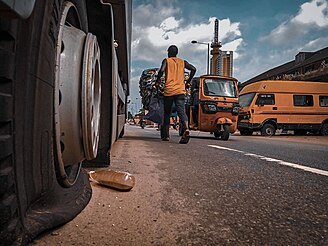
A flat tire in a busy commune in Lagos, Nigeria. A car with a apartment can cause local delays in traffic.
Other causes [edit]
Besides puncturing of the tire a apartment can be acquired by: failure of or damage to the valve stalk; rubbing of the tire confronting the road, ripping the tire, or separation of tire and rim past standoff with another object; excessive habiliment of the tire tread allowing explosive tire failure or assuasive road droppings to tear through it.
Some tires, particularly those with a slow leak, can be repaired and re-inflated; others, especially those with worn tread, must exist replaced.
Driving or riding with a flat tire [edit]
Where a apartment tire occurs, drivers are advised to tedious gradually and pull off the road.[2] Continuing to drive may damage the wheel, the hub or other parts of the vehicle. Driving with a apartment tire, especially at high speeds, may result in a loss of control and peradventure result in a car accident.
On a bicycle, a flat tire will compromise treatment, too as increasing rolling resistance.
Flat tire repair [edit]
Motor vehicles [edit]
A UK source reports that flat tires account for about 10% of motor vehicle breakdowns.[3]
Motor vehicles are normally equipped for changing a tire. These tools include a jack, a tire iron or lug wrench, and a spare tire. Air pumps run by mitt-lever, pressure cans, or electricity can be used to re-inflate slow-leaking tires.
Ane common way to temporarily repair and re-inflate a punctured tire at the roadside is to employ a canned tire sealant. The motorist attaches this to the valve, and the compressed propellant inside forces the can'south contents through the valve into the tire, a liquid sealant is forced towards the puncture and will seal the puncture. The compressed propellant too inflates the tire. Tire sealant is typically useful on punctures of 3/16in. (5mm) diameter or less. Co-ordinate to research carried out past Continental Tires, 95% of punctures are acquired by objects of 5mm or less. Typically, the sealant is a water based latex solution which can easily be removed by a tire repair professional before a permanent repair is made. Canned tire sealants are quick and simple to use and accept the added do good of working when the vehicle is in a dangerous location such every bit at the side of a decorated highway, or on uneven ground.
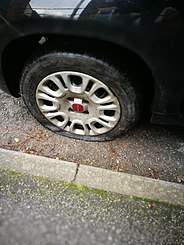
A flat tire on an machine
A h2o-based sealant can be injected into the tire likewise through the valve stem. This contains less harmful chemicals and no aerosol gas. The sealant tin can then be driven into the tire using an air compressor.
A flat tire can exist repaired past a patch or plug;[4] or the tire may repair itself. Self-sealing tires work on punctures up to a certain size.
The patch repair is commonly used in a repair store. Some may not patch a worn tire if: the hole is shut to a previous patch, there are already more than two patches, the puncture requires more than two patches, the punctures are too shut, and/or the puncture is close to the sidewall. A patch is performed past removing the tire, marking the puncture, scouring the surface to create a smooth surface (within of the tire), applying rubber cement, applying the patch, and so pressing information technology into the surface with a small metal wheel attached to a handle. An alternative is a combination patch and plug. This is manufactured with a plug built into it; applying this patch is done similarly except with more steps, including drilling a hole at the puncture and so the plug can exist pulled through it, every bit well as cutting off the excess plug from the outside the tire.
The concluding method, the tire plug, can exist performed without removing the tire. The penetrating object is removed from the tire, and a plug coated in rubber cement then inserted with a handle, typically supplied with the kit. Many technicians consider plugs less reliable than patching though more reliable than sealant.
I disadvantage of patching a tire is that due to the procedure requiring one to remove the tire from the cycle, the tire must be balanced again when it is put back on the wheel. Tire sealant also creates an imbalance in the tire, but since it is a temporary repair, it is considered less of an issue. However, the issue of disposal of the tire sealant, the hazards to the technician, besides as the required cleaning of both the inside of the tire also as the bicycle could all be considered disadvantages of tire sealant.
Tires tin can leak air for a variety of reasons. These include, but are not express to: damage to the wheel itself, a damaged valve stem, a puncture in the tire (which tin be difficult to notice if the puncturing object didn't embed itself in the tire) and improper installation of the tire, which could involve the dewdrop of the tire beingness cut when installed with excessive forcefulness.
Occasionally, a puncture may not "go all the way through" to the inside of the tire. Thus, before coming to the conclusion that a puncture is causing air to leak from the tire, try to remove the puncture lightly past hand. Information technology's very possible that the head of a smash or a very short nail created the appearance of a puncture, while not actually being one.
Also worth mentioning is the fact that tires merely lose air over time. A make new tire, properly inflated, will lose air even with no punctures nowadays. This is mainly due to the design of the valve stem, among other reasons. Given enough time, a tire can fully deflate with no exterior intervention.
Bicycles [edit]
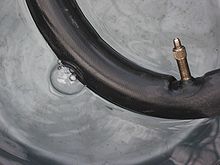
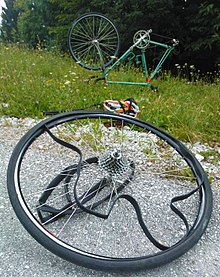
Thin-walled tires, especially those used in route racing bicycles are specially susceptible to puncture by road debris, such every bit thorns, and small pieces of glass that would not affect tires with more substantial tread. The equipment needed to repair or replace a cycle inner tube is comparatively minimal, and frequently carried by cyclists.
On the road, the easiest arroyo to a flat tire, should a spare inner tube be bachelor, is to replace the tube. The bike is removed, the tire levered from the rim and inspected for causes of harm, and the inner tube replaced and bicycle inflated. Re-inflation can exist carried out by the use of a frame mounted pump or a CO2 cartridge inflator. The CO2 cartridge is generally a single use item but while the pump can be used to inflate many flat tires. The inner tube may then exist repaired at a afterward appointment.
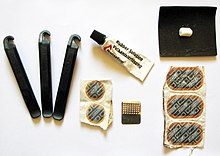
Puncture repair kit, complete with tire levers, vulcanizing fluir, abrasive grater and fabric, puncture patches, and a bit of chalk to marker the puncture
The repair of inner tubes may exist necessary on the route. Several methods exist to locate a small-scale puncture, including submersion in water with dish soap, but without a bowl of h2o bachelor, the simplest method may be to inflate the tube until air can exist felt escaping from the puncture. Once located, the puncture is cleaned, and a patch applied (see Louis Rustin for the invention of the puncture patch). Note that tire valves may besides become damaged. In this case, repair of the inner tube will non be possible, and the tube should be replaced.
Should harm to the tread of the outer tire be substantial, a tough, cocky-agglutinative patch, known as a boot may additionally be placed inside the tire. Folded paper currency is frequently used as a makeshift boot by cyclists in need.
Racing bicycles ofttimes use tubular tires, which are glued to a special, flat bicycle rim. The use of these is frequently restricted to circumstances where a total spare wheel is bachelor.
Another approach to preventing punctures of lightweight tires is to utilise kevlar belts in the tire tread construction.
Another approach to preventing punctures in bike and other tires in general is the utilize of Slime, a proprietary brand of injectable liquid thick chemical goo.[ commendation needed ] This chemic "goo" has a tendency to stick to, and glaze the outer wall of the inner tube or tire, thus adding another layer of flexible rubber-type protection on the inside of the inner tube or tire. Many MTB riders, or "Mountain Wheel Riders", further pre-treat their tires to prevent serious punctures or to prevent punctures in the start place. At that place are other brands of this aforementioned type of liquid, either in an unpressurized container or pressurized container with inflatable gas which is sold in many automobile and bicycle stores. The auto sales version of this Fix-A-Flat type of chemical is sold in America.[ citation needed ]
Dangers of changing a flat tire [edit]
Motorists stranded by a flat tire confront a number of hazards.
The most common hazard is from the passing traffic.[ commendation needed ] Especially if the tire is on the side closer to the road, the motorist is at risk of getting hit by a passing car. If the motorist is unable to pull over to a identify where the tire being changed is on the contrary side from the moving traffic, he may be directly in the path of or merely inches away from passing cars. Even if some type of warning is placed on the road, a motorist not fully attentive may not be able to avoid the situation.
Some motorists, particularly those with less physical strength, may risk injury while attempting to change a tire. Often, lug basics are bolted very tightly to the wheel, and tires themselves are quite heavy.
While the use of a run-flat tire can foreclose these problems, some run-apartment tires have other inherent flaws that make them less appealing.
See as well [edit]
- Tweel - Michelin's air-complimentary tire
- Tire manufacturing
- Tire Pressure Monitoring System
- Tire mousse
References [edit]
| | Wikimedia Eatables has media related to Apartment tires. |
- ^ AUTOS & BOATS : Tires : Tips: Tire Care and Preventing Flat Tires : DIY Network
- ^ "What to Practice if Yous Have a Blowout on the Highway". Archived from the original on 2007-10-20. Retrieved 2007-07-03 .
- ^ "Breakup company call outs: Pinnacle reasons for breaking down". Breakdownrecovery.co.united kingdom. Archived from the original on 2009-04-06. Retrieved 2009-12-08 .
- ^ "Which is better: Tire Patch or Tire Plugs? | NeverFlat by Pansky". 12 Volts Portable Tire Inflator | NeverFlat past Pansky. 2020-08-02. Retrieved 2020-08-02 .
Source: https://en.wikipedia.org/wiki/Flat_tire
0 Response to "Kids Bike Tyre Puncture Again and Again Even if There Is No Nail"
Postar um comentário